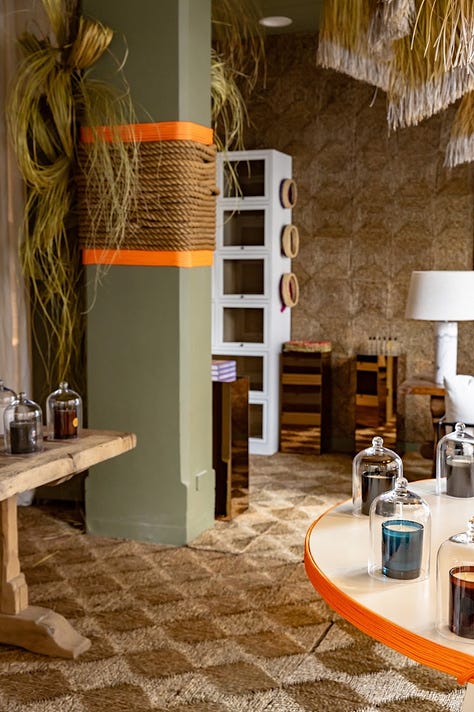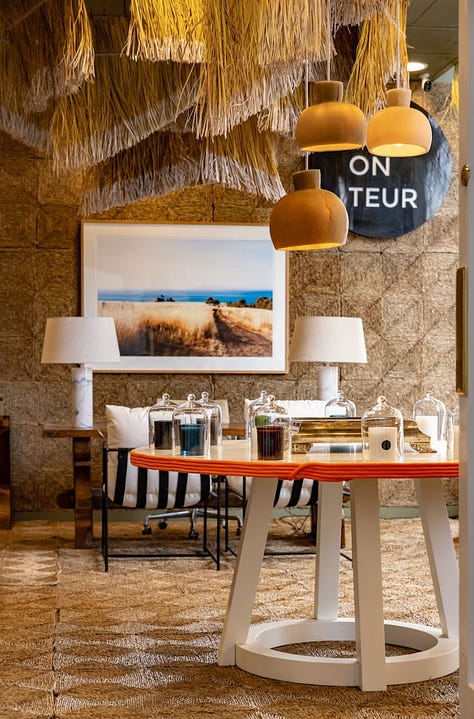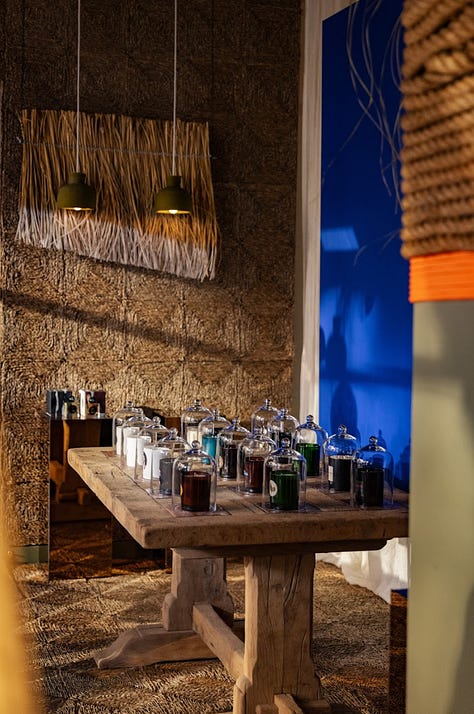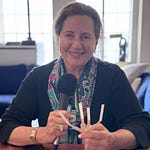The Raconteur Founder and Perfumer Craig Andrade, graced us with his presence in the Perfume Room last week. The Raconteur is an artisanal luxury fragrance brand based in Sydney and Hobart, Australia that specializes in botanical fragrances using Australian native plant extracts, and Craig is former law firm partner-turned-perfumer!
Finally, exclusively on Substack, enjoy the FULL VIDEO episode (above)! This is a paid subscriber perk, but there is a 6-min free preview for everyone. And if you don’t have video access, but would like to listen to the full episode, you can do that right below!
This week, Craig is in The Other Room sharing more about Australia’s rich perfume culture, what he deems the ‘Australian-style’ of perfumery, and he also gives us a glimpse into his [beautiful] daily life in Tasmania.
The Other Room is the official Perfume Room companion post-show. Every Tuesday, hear from guests on their episode of Perfume Room podcast, and later that week, enjoy bonus content from those same guests, exclusively on Substack!
A GIFT FOR YOU!
NOW THROUGH JULY 31, USE CODE: Emma10 TO ENJOY AN EXTRA 10% OFF FULL BOTTLE OF THE RACONTEUR FRAGRANCE AT STÉLE.
How would you describe the perfume culture in Australia?
Hmm. This is a complex question. In short, there’s two parts to the answer. On the one hand you have Australia’s First Nations People, who practice the world’s oldest continuous cultures, with over 60,000 years of deep spiritual, cultural, and environmental connection to the land now called Australia. Despite the profound disruption of colonisation, their diverse languages, traditions, and systems of knowledge rooted in their unique relationship with Country are enduring.
Scent isn’t used purely for adornment (like in classic Western tradition). However, there are rich cultural traditions associated with the use of Australian native botanicals as part of:
food (eg Kakadu plum, quandong, muntries, lilly pilly)
ceremony (e.g., smoke as part of cleansing and welcome to Country ceremonies);
medicine (e.g., lemon Myrtle for calming; emu bush leaves burned for spiritually protective smoke)
marking the memory of Country (e.g., to mark sacred places, track animals, or identify seasonal changes)
ceremonial body scenting (e.g., as part of taking in the spirit of a plant)
totemic relationships with certain clans (these plants are treated with deep reverence. These relationships are sacred, passed through songlines, dreaming stories, and kinship systems — and generally are not public knowledge out of respect for cultural privacy and custodianship of who gets to pass this knowledge down to whom).
On the other hand, you have our more classic western notions of scent and how we use scent, principally as a form of adornment, identity, and fun. I think Australians on the whole have a very Euro-centric set of beliefs when it comes to their references for what good smells like. They tend to lack confidence in celebrating the beauty of their own backyard and the richness of what our botanicals offer.
I found that rather concerning when I entered this industry. It was almost as if certain brands were trading on this elitist view that if it came from France it had to be good and they talked down the scent of anything that was actually made in Australia, celebrating Australian botanicals.
It certainly got under my skin and I thought to myself: we can do better than this.
This all got a bit more complicated when I started to see overseas perfumers sitting in France or NY trying to create scents that defined the scent of Australia. While it was fine for them to have a go, I think this robbed us of our agency to tell our own stories with scent the way we would if we were working on the ground, in Australia, living and breathing our raw materials through our own lived experience. I won’t go so far as to say this almost like another form of colonialism with foreign perfumers defining what Australia is, or is not, but it certainly got under my skin and I thought to myself: we can do better than this.
If you had to generalize the style of Australian perfumery (compared to say French perfumery or American perfumery), how would you describe it?
I think American styles are generally very clean, crisp, fresh, preppy. Whereas the French are generally more sexy, dirty, flirty — with scent as wearable art and a bit more risk-taking. I think Australian perfumery as a style is generally still very young, but it tends to gravitate more towards the clean, fresh, American style than the French.
Australian scents tend to be very safe and classic or derived from classics (chypre, fougere, cologne etc).
And let’s get a bit more broad. You’ve lived quite a global life—what are the hallmarks of Australian culture?
I think we have a relaxed and friendly culture. We obsess about being by the water, who is kicking a ball or winning (aka “sports”), eating well (we are spoiled with exceptional produce), drinking well (ditto wines and spirits), living well (ditto landscape, nature, beaches) and we have an extraordinary set of values that underpin the nation, where fairness, decency and having a go are bedrocks. There’s a realness and a toughness that goes with living on such a harsh dry continent (i.e., no tolerance for BS), but also an incredible kindness among Australians as we live so far away from the rest of the world.
What is your favorite Australian botanical (whether it’s a perfumery material or not…)?
I reckon this has to be King Billy and Huon Pine, two incredible Tasmanian native trees that are protected endemic species found only in Tasmania. They have an incredible woody aroma that’s nothing like pine, and is probably closer to Cedarwood from the Atlas Mountains in Morocco.
We didn’t have a chance to discuss your incredible Troye Sivan collab, with 5755! Can you tell us a bit about the collab/how it came about?
I was approached by Troye’s brother, Steele, by DM on Instagram. We got chatting and because of the Australian, ex-South African, ex-lawyer, connection we hit it off immediately and it was a good fit to design Troye’s signature scent for the lifestyle brand he was launching with Steele.
You lightly touched on your reincarnation hypothesis (that of an 1820s man). Let’s unpack that. How do you come to this revelation?
Haha! Wow. This is so deep. Well, there are some things you can’t explain. Like when you know your soul is happy, you’re in the right place, doing what seems to effortless, without friction. And charm is everywhere. That’s how I feel about living in Tasmania. And that’s how I feel whenever I’m surrounded by Georgian architecture. There’s something about the proportions, the symmetry, the simplicity, the understated grandeur that just gets me.
Each house I have ever lived in in Australia has generally been from the 1800s—I’ve gone from the 1890s (a terrace in St. Kilda), to the 1860s (a colonial farmhouse in Sydney’s northern beaches), to the 1820s (a Georgian sandstone farmhouse in Tasmania). It’s got a touch of Dorian Gray vibes about it as I feel like each decade I go back in time in these old houses, even though I’m getting older, I’m weirdly feeling younger and more energised about this new chapter of my life as a perfumer.
I feel incredibly content living in an old home with all of its charm, imperfections and history. I guess I’m a deep romantic at heart who loves all of this layering. I feel there’s so much beauty and meaning in knowing the history of a place, the stories of previous occupants, and I often reflect on what life was like for each of them. [Ed. Note: 🥹]
What’s a typical day like for you?
I tend to get up at 6am every day in winter (5am in summer — it’s so light in Tasmania), and head out to walk the dogs on the farm with a giant mug of coffee. I then meditate and do an hour of farm work before heading in to my design studio in Hobart.
I run 2 physical stores (Sydney and Hobart) and have an online business so I’ll usually scan online orders from overnight and set the day’s priorities for the team before getting stuck into my design work. I’m either working on my own scent creations or working on scents for other brands.
I’ve spent the last year working with a design team on the master plan for the farm and that was recently approved by my local Council. So a big part of the next 12 months will involve daily and weekly site meetings with my architect and builder as we construct new visitor accommodation and a big retail barn and manufacturing facility. I’m building a “paddock to perfume” farm experience.
My day usually ends with an evening mediation, dog walk, and time in the veggie garden as I forage for what I’m going to be cooking for dinner. In winter, there’s always a fire to be lit, a book to be read, and a slowness to be celebrated as we hibernate indoors. [Ed. Note: once again, 🥹]
What are you strongest scent memories from your childhood in South Africa?
I have cousins still living in South Africa. But my mum lives in Australia. In fact, she also moved to Tasmania (from Sydney) shortly after I decided to move to the farm. She has a house in Battery Point (the oldest suburb of Hobart, complete with an extraordinary range of Georgian and Victorian houses) and actually works in my business. Each day she walks down to the store in Hobart and she plays a key role in helping me to run the business. So it’s quite a beautiful thing to have my mother in my life every day.
I’d love to learn more about Tassie. What’s Hobart like? What’s Morrison St. like? Is it mainly a vacation destination?



Tassie is an incredible island state at the bottom of Australia. It’s well known for its beautiful and pristine natural environment, (great hiking, cleanest air, cleanest water), exceptional produce and wine, vibrant arts culture, and a general reverence for meaning that is linked to all of the above rather than the traditional hustle of a transactional city culture.
It has 4 very clear and distinct seasons a year and the cycle of all activity is firmly anchored by the dictates of Mother Nature. Because the produce is so bountiful, it feels like every weekend in summer there’s a festival for a vegetable, followed by an outstanding arts event, or a hiking trip to a vast coastline with barely another soul. Winters are definitely cold (0 to 10 degrees Celsius and it snows in the highlands) and everyone gears up for it with fires, hearty indoor living and chance to go quiet before fresh spring renewal and a vibrant outgoing summer. I feel very lucky to live here and still dip my toes once a month into Sydney or Melbourne.
Given all of the above, Tassie has a very big tourism economy. It also has a very high percentage of people working in an arts or creative industry. And Mona, our iconic local art gallery, is a massive driver of exceptional art curation. Its annual 2-week long winter festival, Dark Mofo, is probably one of the most forward leaning contemporary arts festivals in the world.
Farm pics please?!
I don’t have much to share re the farm as it’s all still a WIP and the building work hasn’t commenced yet. So probably just a shot of the dogs for now. lol.
Thank you Craig! :)
SHOP: Stele.shop (now-July 31, use code: emma10 for 10% off any Raconteur bottle!)
FOLLOW: @the_rac_on_teur
Listen to this episode with a 7-day free trial
Subscribe to Perfume Room Substack to listen to this post and get 7 days of free access to the full post archives.
















